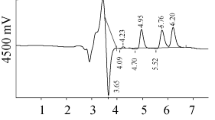Abstract
Small peptides are often endowed with useful biological activity and two of these are l-leucyl-l-leucine methyl ester (1) and glycyl-l-glutamine (2). To advance research in this important area, they were tritiated at high specific activity. [3H] l-Leucyl-l-leucine methyl ester (5) was prepared by the reaction of [3H] l-leucine methyl ester (4) with BOC-Leu-OSu. [3H] Glycyl-l-glutamine (7) was synthesized by the reaction of [3H] l-glutamine with BOC-Gly-OSu. Biosynthesized from l-lysine and l-methionine, related small molecule l-propionylcarnitine taurinamide (3) was also tritiated, employing [3H] taurine (10) and l-propionylcarnitine acid chloride (9).




Similar content being viewed by others
References
Hermans J (2011) The amino acid dipeptide: small but still influential after 50 years. Proc Natl Acad Sci 108:3095–3096
Gulyas EC, Soos K, Varga J, Toth G, Penke B (1998) Synthesis of tritium-labelled beta-amyloid fragments. J Label Compd Radiopharm 41:763–771
Schmidt HL, Werner G (1965) The radiolabelling of d, l-glutamine with tritium. J Label Compd Radiopharm 1:304–305
Fellman JH (1981) The synthesis of [2-3H2] taurine and [2-3H2] hypotaurine. J Label Compd Radiopharm 18:765–768
Thiele DL, Lipsky PE (1990) Mechanism of the l-leucyl-l-leucine methyl ester-mediated killing of cytotoxic lymphocytes: dependence on a lysosomal thiol protease, dipeptidyl peptidase I, that is enriched in these cells. Proc Natl Acad Sci 87:83–87
Filicko-O’Hara J, Grosso D, Flomenberg PR, Friedman TM, Brunner J, Drobyski W, Ferber A, Kakhniashvili I, Keever-Taylor C, Mookerjee B, Talano J-A, Wagner JI, Korngold R, Flomenberg N (2009) Antiviral responses following l-leucyl-l-leucine methyl ester (LLME)-treated lymphocyte infusions: graft-versus-host-infection without graft-versus-host disease. Biol Blood Marrow Transplant 15:1609–1619
Hsieh MH, Varadi G, Flomenberg N, Korngold R (2002) Leucyl-leucine methyl ester-treated haploidentical donor lymphocyte infusions can mediate graft-versus-leukemia activity with minimal graft-versus-host disease risk. Biol Blood Marrow Transplant 8:303–315
Rosenfeld CS, Thiele DL, Shadduck RK, Zeigler ZR, Schindler J (1995) Ex vivo purging of allogeneic marrow with l-leucyl-l-leucine methyl ester. Transplantation 60:678–683
Hasegawa H, Shinohara Y, Baba S (1990) Synthesis of [D-Ala2] leu-enkephalin and [D-Ala2, D-Leu5] leu-enkephalin with high specific tritiated activity in the leucine residue. J Chem Soc Perkin Trans 1:2641–2644
Baba S, Hasegawa H, Shinohara Y (1989) Synthesis of high specific active tritiated leu-enkephalin in the leucine residue. J Label Compd Radiopharm 27:1359–1369
Williams PG, Morimoto H, Wemmer DE (1988) Application of modern 3H NMR techniques to analysis of complex isotopic products from a hydrogenation reaction. J Am Chem Soc 110:8038–8044
Resch GE, Simpson CW (2008) Glycyl-glutamine reduces ethanol intake at three reward sites in P rats. Alcohol 42:99–106
Cavun S, Goektalay G, Millington WR (2005) Glycyl-glutamine, an endogenous beta-endorphin-derived peptide, inhibits morphine-induced conditional place preference, tolerance, dependence and withdrawal. J Pharmacol Exp Ther 315:949–958
Goektalay G, Cavun S, Levendusky MC, Hamilton JR, Millington WR (2006) Glycyl-glutamine inhibits nicotine conditioned place preference and withdrawal. Eur J Pharmacol 530:95–102
Zhang Y, Yan H, Lv S-G, Wang L, Liang G-P, Wan Q-X, Peng X (2013) Effects of glycyl-glutamine dipeptide supplementation on myocardial damage and cardiac function in rats after severe burn injury. Int J Clin Exp Pathol 6:821–830
Lazzarino G, Corsico N, Tavazzi B, di Pierro D, Arrigoni-Martelli E, Giardina B (1992) l-Propionylcarnitine taurine amide induces the metabolic recovery of the isolated postischemic rat heart. Cardiologia 37:715–717
Regitz V, Paulson DJ, Noonan J, Fleck E, Shug AL (1987) Protection of the ischemic myocardium by propionylcarnitine taurine amide. Comparison with other carnitine derivatives. Zeitschrift fuer Kardiologie 76:53–58
Acknowledgments
We would like to acknowledge the contribution of Dr. Puliyur Srinivasan in obtaining the tritium NMR spectra.
Author information
Authors and Affiliations
Corresponding author
Rights and permissions
About this article
Cite this article
Egan, J.A., Filer, C.N. High specific activity tritium labelling of biologically active small peptides and a related analogue. J Radioanal Nucl Chem 307, 549–553 (2016). https://doi.org/10.1007/s10967-015-4158-6
Received:
Published:
Issue Date:
DOI: https://doi.org/10.1007/s10967-015-4158-6




